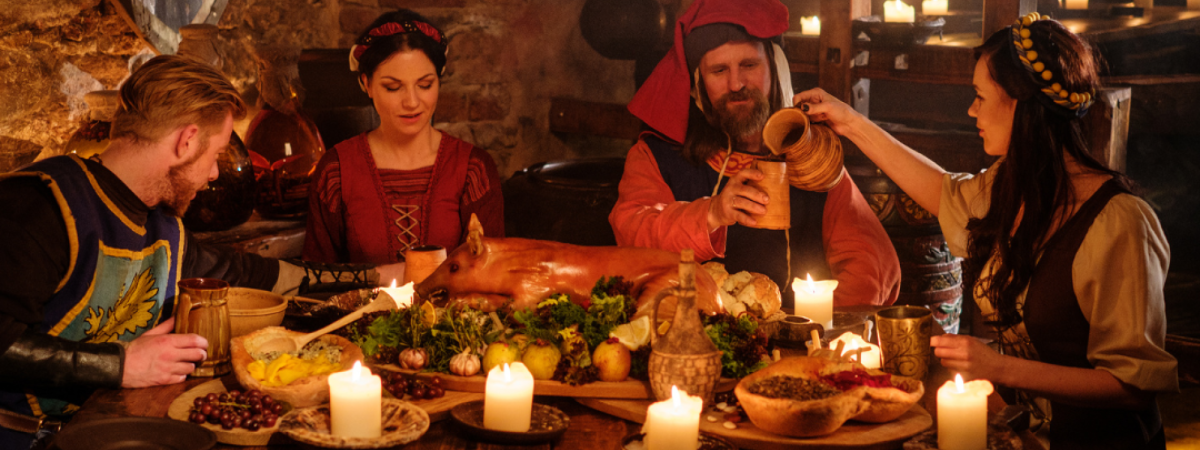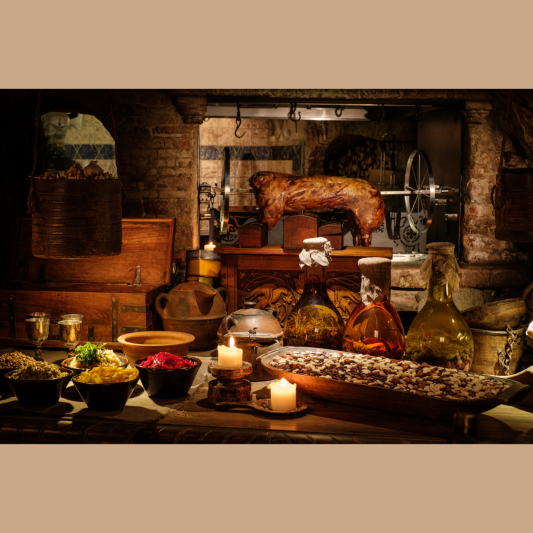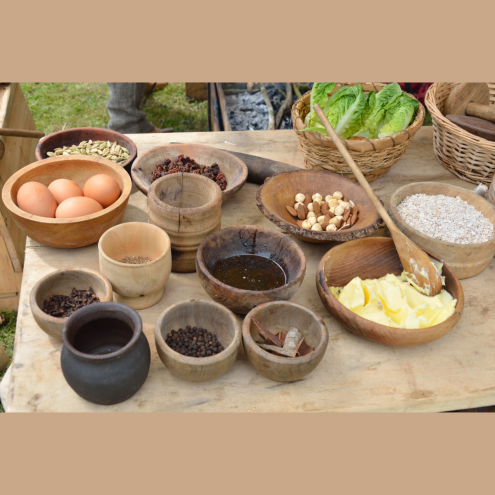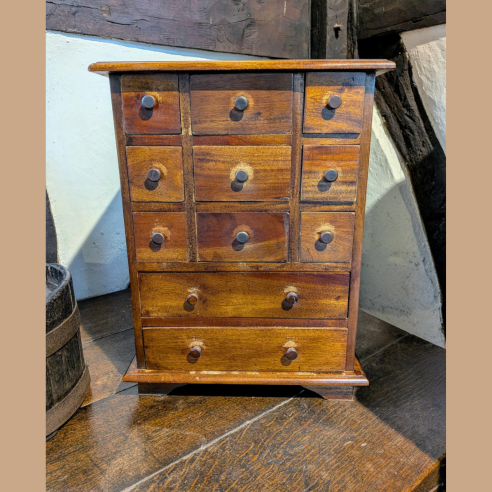Fast Food Goes Medieval: Takeaways in the Time of Knights and Castles

Share
Fast Food Goes Medieval: Takeaways in the Time of Knights and Castles
Let’s say you time-travel back to medieval England — you've survived the dodgy drinking water, you're rocking a tunic, and suddenly... you get the munchies. What’s a hungry time-traveller to do? Could you grab a takeaway like you do now? Let’s see if your favourite fast foods could be recreated using only the ingredients and cooking methods of the Middle Ages.
Selly Manor Museum is made up of two buildings: our 500-year Tudor house, and our medieval Hall-House Minworth Greaves. Minworth Greaves is a timber medieval cruck framed hall, which is thought to date back to the early 1300's. It was purchased by Cadbury family in a ruinous state and moved from its original location in Minworth, Sutton Coldfield. We believe it would have a been a large home for the time, with small high windows carved in the wattle and daub walls with animal-fat-soaked cloths to cover the openings. Many building of its kind would have functioned as communal living spaces with their cooking, sleeping and living areas all with the same large room. To make matters more interesting, it was common practice to bring livestock in of an evening to keep them safe and second as way of heating in the winter. Talk about cozy!

Image Above: Medieval cooking methods mostly involved using open fires, communal ovens, and various techniques to prepare a wide range of dishes.
Fish and... Just Fish
You’re craving a chippy tea – classic fish and chips. Could medieval you pull it off? Sort of.
Fish? No problem. Cod, haddock, and other swimmers were all on the menu back then. Frying? Yep – folks used ale and flour to make batter, since water was often too filthy to trust. But sorry – no chips. Potatoes didn’t show up in England until the late 1500s, after being introduced from South America. You’d be stuck with battered fish... and maybe a hunk of bread.
Fun fact: Fish and chips became a national favourite during WWII because they weren’t rationed. Plus, they were cheap and filling – like all good comfort food.
Pizza… Hold the Tomatoes
Could you make a medieval pizza? Sort of!
Tomatoes were still chilling in the Americas, totally unknown to England. So no tomato sauce – disaster! But you could have a pizza bianco (that’s fancy talk for “white pizza”): a flatbread base topped with local cheese and herbs. Think of it as pizza’s great-great-grandparent.
Want tomato sauce? You’ll have to hang around for another couple of centuries and wait for Victorian gardeners to get into it.

Image Above: The medieval diet was high in carbohydrates, with most of the budget spent on cereals and alcohol (such as beer). Unfortunately, nothing as tasty as coco-pops.
Medieval KFC: Finger-Lickin’... Kinda
Could you deep-fry chicken in medieval times? Yes! People were already frying things in fat, and chickens were everywhere. But what about Colonel Sanders’ secret blend of 11 herbs and spices?
You’d have some: garlic, mustard, basil, oregano, thyme, salt, pepper – tick. But forget about paprika, chilli, and MSG (medieval chefs weren’t into lab-made flavour enhancers). So, it wouldn’t taste like KFC, but it might come close. And again… no chips. Stop asking.
BTW, the first UK KFC opened in Preston in 1965. Northern pride!
Curry Time! (Surprisingly Possible)
No, you wouldn’t get a spicy tikka masala with garlic naan on a medieval high street. But could you make something curry-ish? Definitely.
Medieval cooks were into their stews, and spicy ones at that – if they could afford the exotic spices. You’d have black pepper, cloves, ginger, cinnamon... all thanks to medieval trade routes. But no chilli, turmeric, or cumin (those showed up later). So your curry would be more “mild medieval mush” than “blow-your-head-off balti.”
Want the real deal? You’d have to fast-forward to 1810 and visit the first Indian restaurant in London – or hold out for Birmingham’s Darjeeling restaurant in 1954.

Image Above: This is a picture of our Spice Box in the Selly Manor Museum Kitchen as an interactive element. Our visitors can smell a multitude of spices like cinnamon, cloves and star anise!
Burger Me!
Yes, you can build a burger in medieval England – and it might actually be decent.
Bread? Check. Cheese? Yep. Beef? Kind of – cows were mainly milk machines, but you could get meat if you knew the right farmer. Gherkins, onions, mustard? All there! Just don't ask for tomato ketchup – not invented yet – (it was invented in the 18th Century and then, it started as a fermented fish sauce from Asia). Still, you’d have a bun, a patty, and plenty of flavour.
Fun fact: Long before McDonald's invaded the UK in 1974, Brits were scoffing burgers at Wimpy Bars in the 60s and 70s. Respect to the OG burger joint.
Doner Kebab: The Drunken Knight's Dream
It’s late. You’ve had too much mead. You need a kebab. Could medieval you stumble into a kebab shop?
Surprisingly – yes!
You’d have pita-style flatbread. You’d have salad bits like lettuce, cabbage, onion, cucumber (but no tomatoes – again). Lamb? Totally – though medieval sheep were about the size of a Labrador. Spices? Oh yes – coriander, cinnamon, nutmeg, cardamom, garlic... Basically, everything except chilli sauce.
So, you could absolutely smash a kebab – just don’t expect the full flame-grilled, spicy-sauced version we know today.

Picture Above: Medieval meals were communal affairs. The entire household would dine together, including servants.
Final Thoughts (and Regrets About Chips)
So, could medieval England do takeaways? Sort of. While many ingredients we love today hadn’t made it across from the New World, people in the Middle Ages were resourceful, adventurous with their cooking, and definitely up for a fried treat or two.
Next time you grab a kebab, pizza, or chicken box, remember – you're basically enjoying the future versions of some surprisingly medieval munchies. Just... don’t expect fries with that.
Written by Simon, Museum Volunteer.
Edited by Megan, Museum Assistant.